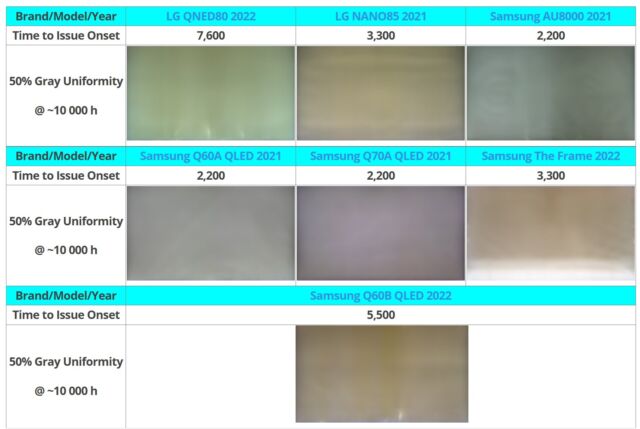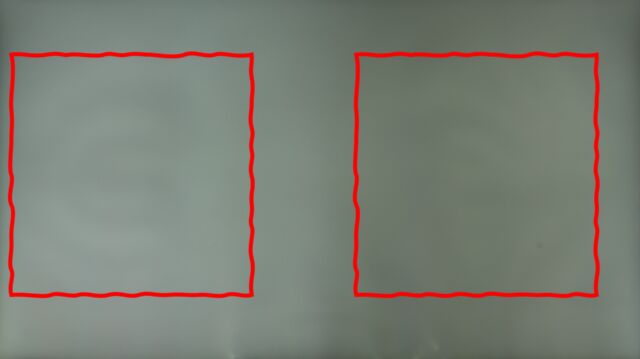Testing shows “significant durability” problems with edge-lit LCD TVs

Samsung
Thin LCD-LED TVs are appealing because they’re easy to find space for and are aesthetically pleasing. To stay slim, most thin TVs, like Samsung’s The Frame pictured above, use edge-lit backlights. But beyond the image quality limitations of these designs, new testing from RTINGs suggests that there are inherent flaws in edge-lit TV designs that hurt durability.
Review site RTINGs has been running extreme tests on dozens of TVs and a few monitors that are meant to simulate years of use. So far, RTINGs is up to 10,000 hours of testing, which it says is equivalent to about six years of use. In a YouTube video this week, a representative for the publication’s research team said that in the past few months, testing has revealed a “clear, but troubling trend” of LCD TVs with edge-lit backlights being “inherently prone to significant durability issue.” She added that edge-lit TVs “fail faster than other LCD TV designs,” or those with full array local dimming (FALD) or direct-lit (or global dimming) backlights.
For its torture test, RTINGs tested 11 edge-lit TVs and reported that seven of them have “noticeable” uniformity issues. Of those seven, two models are from LG, and five are Samsung TVs.

That’s not a massive sample, but RTINGs’ rep noted that “that’s 64 percent of one type of TV with issues, compared to 20 percent of both” FALD and direct-lit models tested.
Per RTINGs’ spokesperson:
The results of our investigation conclude that edge-lit TVs are prone to failure earlier than other LED designs, like full array local dimming or direct-lit designs. These issues are brand agnostic.
Three main issues are causing the uniformity problems, which have been getting worse on all but one of the seven affected edge-lit TVs, RTINGs said: warped reflector sheets, cracked light guide plates, and burnt-out LEDs. These problems are reportedly surfacing after extended use of the devices with the brightness cranked to the maximum.

When reached for comment, a Samsung representative told RTINGs that it’s been using edge-lit tech in products “reliably” for over 15 years and that the company “continuously improved the optical components and thermal management of edge-lit models, subjecting them to over 20 long-term reliability tests, including high-temperature testing.” LG told the publication that it had not seen any difference in the defect rate between edge-lit and FALD or direct-lit LCD TVs.
Hot spots
As is often the case with display deformities, the big factor here is heat dispersion.
Because edge-lit displays have heat concentrated in a few (usually one to four) areas along the display’s border, heat is more concentrated than the heat generated by FALD or direct-lit backlights. For example, LG’s QNED90 2022 TV has 180 LEDs on the bottom compared to the Sony X90L’s 160 LEDs that are spread out across the entire back chassis. Even though brighter TVs tend to get hotter, the dimmer LG TV showed hot spots that the Sony didn’t, with its LEDs measuring a whopping 123° C (253.4° F) with the TV at max brightness (RTINGs didn’t specify how long it took for the LEDs to reach this temperature or the temperature of the Sony TV’s LEDs).
This level of heat can warp the TVs’ reflector sheets, which aren’t pinned down like they are in FALD and direct-lit LCD TVs. “This means that there’s nothing keeping that sheet taut and tight inside the TV. so it warps,” RTINGs’ rep explained. According to the publication, every TV that it opened with edge-lit backlight had a reflector sheet that showed some sign of warping.
Edge-lit TVs also use polymer light guide plates, which other types of LCD TVs don’t have, for light diffusion. These plates are also impacted by high temperatures of LEDs, despite the TVs having heatsinks, as only plastic standoffs separate the plates from the diodes. Combined with the stress “caused by the TV heating up and cooling down rapidly,” RTINGs said it’s seeing light guide plates crack, creating visible streaks of light shooting from the border(s) where the backlight is.
Extreme examples of light guide plate damage include the LG QNED80 from 2022, which RTINGs said has over 25 cracks, and the Samsung AU800, whose plastic standoffs melted, resulting in the light guide plate sliding and fusing with the strip of LEDs south of it.
Such high temperatures can also result in the LEDs in edge-lit backlights burning out, which can result in a bluish tint in the TV’s image.

